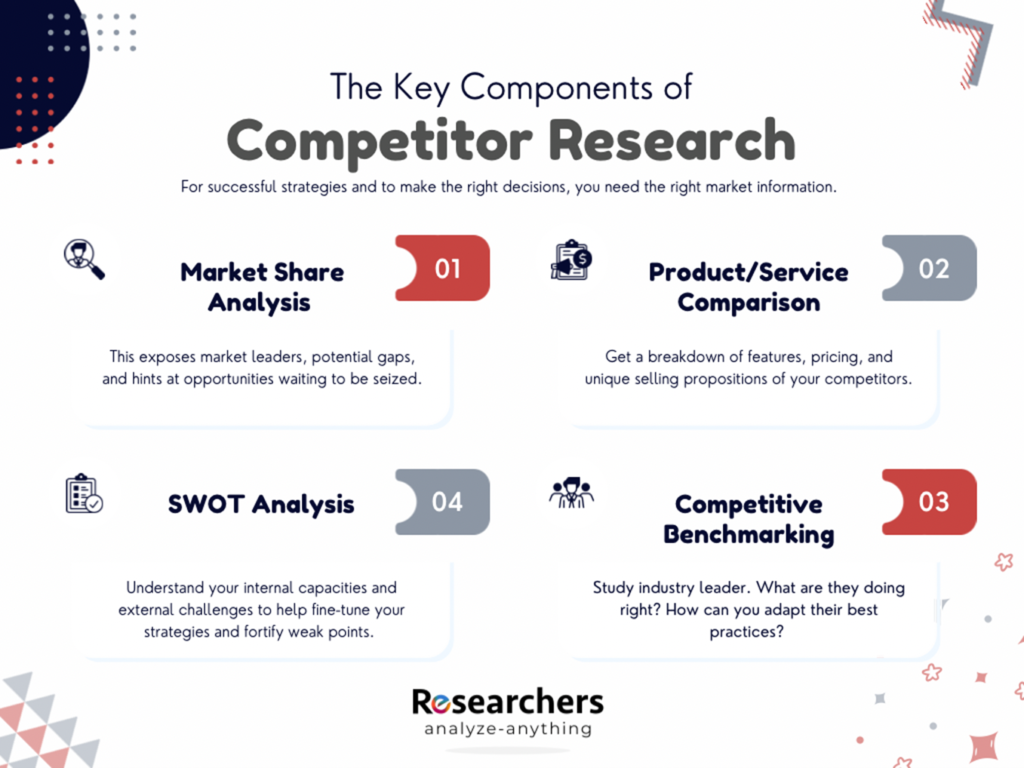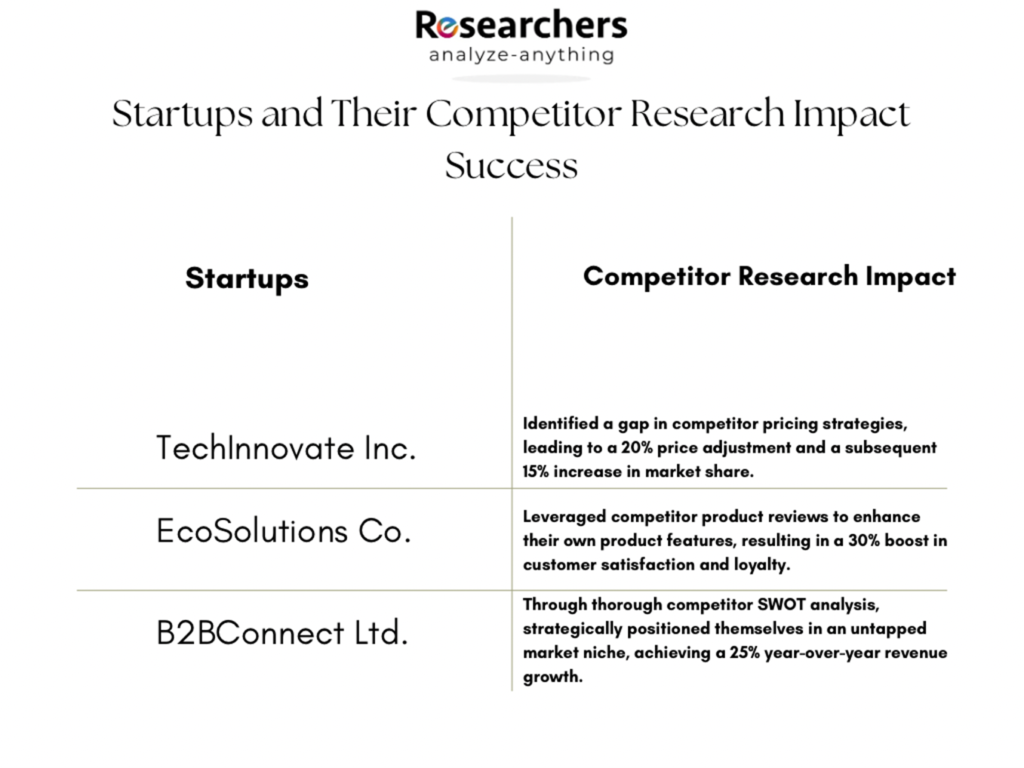Every move you make as a startup shapes your destiny in your market. Competitor research is the compass that points you in the right direction and unravels the secrets of your competitive landscape. Surveys and research consistently underscore its significance—87% of successful startups attribute their victories to a keen understanding of competitors. In the first ten years of establishment, 65% of new businesses fail.
Competitor research marketing is the difference between a blindfolded leap and a calculated soar. 73% of startups that conducted thorough competitor analysis reported a noticeable increase in profitability within a year. Do you still doubt what choices you need to make to make that big break?
As we embark on this journey, remember, knowledge is power. And the power you’re about to gain will propel you past competition and into the stratosphere of success.
Why Competitor Research Matters?
The United States Bureau of Labor Statistics reports that the percentage of enterprises that fail grows over time. The majority of the failure occurs in the first ten years of operation. The report also informs us that 65% of these startups fail in the first ten years. These failures would have never surfaced if they embraced Competitor Research Analysis.
Competitor research helps you gain a panoramic view of your field. It’s the difference between a chess master making each move with purpose and a novice playing blindfolded. The impact is profound – 89% of startups that integrate competitor insights into their strategies experience a significant boost in decision-making efficacy.
Beyond the tactical advantage, competitor research identifies opportunities that others might miss and mitigates risks before they materialize. Startups leveraging comprehensive analysis frameworks tend to discover new avenues for innovation and successfully navigate potential pitfalls.
Key Components of Competitor Research
A competitor research analysis encompasses various components. These are the ingredients that harmonize to make your startup successful. Each component is important, pay close attention.

Market Share Analysis
This is the beating heart of Competitor Research. It reveals who holds the melody and who echoes in the background. It’s not merely about size but about influence. A startup that diligently conducts its market share analysis is more likely to carve a niche for themself. It involves evaluating a company’s revenue in relation to the total market revenue. This exposes market leaders, potential gaps, and hints at opportunities waiting to be seized.
Product/Service Comparison
Comparing your offerings with competitors is not done with imitation in mind. It’s about differentiation. You get a breakdown of features, pricing, and unique selling propositions of competitors. This provides clarity on where your product stands (or should stand) in the grand narrative of consumer choices.
SWOT Analysis
As a startup, your self-awareness is your greatest strength. The SWOT analysis—examining Strengths, Weaknesses, Opportunities, and Threats— is the mirror reflecting an honest reflection. Understanding your internal capacities and external challenges helps fine-tune your strategies and fortify weak points. Always focus on your strengths as a startup, capitalize only on favorable conditions.
Benchmarking Against Industry Leaders
If you want to become excellent as a newbie, study industry leaders like your life depends on it. No, it’s not as weird as it sounds. You’re not trying to imitate them, you’re only carving out a niche for yourself. Austin Kleon’s Steal like an Artist explains how you aspire to become like your role model. And though you might never turn out like them (because that’s fraud), the artist in you gets inspired to build something unique. Something that is known to the world as 100%you. 100% authentic.
Ask these questions: what are they doing right? How can you adapt their best practices? This component elevates competitor research from a tactical tool to a strategic compass.
Tools and Techniques for Competitor Research
Harness the power of technology with a plethora of online tools specifically designed for competitor analysis. Platforms like SEMrush unveil the digital strategies of competitors. They provide insights into keywords, ad spend, and organic traffic. Social media listening tools such as Brandwatch track sentiment and engagement of social media users. They help you unravel the social tapestry of competitors.
Industry reports are also used to carry out competitor research analysis. These comprehensive documents encapsulate market trends, consumer behavior, and competitor landscapes. Reports from reputable sources like IBISWorld and Statista help startups stay attuned to industry shifts.
You can go back to the old and trusted survey methods. The human touch helps your research come alive through. Crafted with precision, surveys extract firsthand insights from consumers. They unveil preferences, pain points, and brand perceptions. SurveyMonkey and Google Forms empower startups to gather valuable qualitative data that complements quantitative analysis. Incorporate charts and tables into your competitor analysis report. 65% of people are visual learners. You get a comprehensive understanding when information is represented with visual aids.

Tips for Effective Competitor Research
Startups need the right moves to outmaneuver their rivals. Here are practical tips to conduct thorough and impactful competitor research:
- Begin with a clear understanding of your goals. What insights are you seeking? Establishing objectives guides the entire research process.
- Diversify your data sources. Combine online tools, industry reports, and customer surveys for a holistic view of the competitive landscape.
- Dive into customer reviews of your competitors. Unfiltered feedback unveils strengths, weaknesses, and aspects that matter most to your shared audience.
- Conduct SWOT analysis regularly. Markets evolve, and so should your understanding of competitors.
- Embrace the art of mystery shopping. Experience your competitors’ products or services firsthand to identify gaps and areas for improvement.
- Establish alerts for competitors’ activities. Automated notifications keep you informed about shifts in their strategies in real-time.
Conclusion
We’ve uncovered the strategic significance of understanding and outsmarting rivals. From dissecting market share to embracing adaptability. Startups armed with comprehensive competitor insights are better suited for success. As we conclude this exploration, remember that competitor research is an ongoing expedition. It refines your strategies, unveils opportunities, and shields you from risks.
For startups seeking to elevate their competitor research to unparalleled heights, consider the invaluable resources awaiting you at researchers.me. This top-tier market insights firm stands as a beacon, offering tailored strategies, data-driven solutions, and expert guidance. With researchers.me as your ally, your business is on its way to boundless success.

